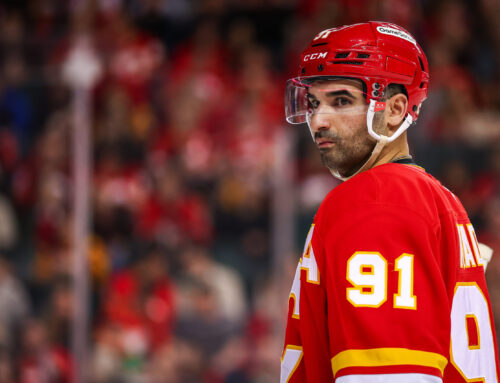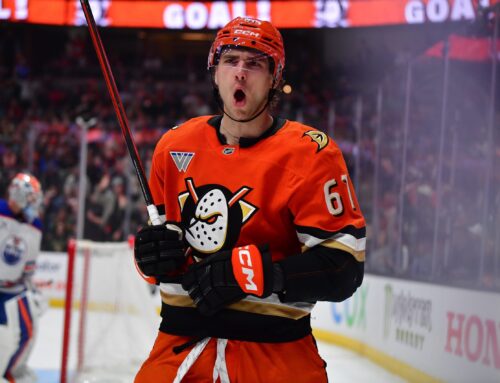Last week, I took a shot at naming the top 10 disappointing players of 2019-20. As I mentioned at the time, it was a much more difficult task than normal, as my original list had 55 names.
To make sure I could include more players, I decided to break it down into two groupings. Last week, I looked at veterans, but this week, I wanted to focus on the younger players. To clarify, I am looking at those who have played four seasons or less in the NHL.
If you prefer to remain positive and look at the glass as half-full, instead of thinking of these players as disappointments, you might want to consider this a list of players to target in keeper leagues. Their value will be down quite a bit from last summer and this would be a good time to inquire about the price of some of these players.
10. Lias Andersson
At times, it almost feels like the Rangers' coaching staff don't want to rebuild as it seems like it takes a long time for young players to be put in a position to succeed. This season, it feels as if everything that could go wrong for Andersson did go wrong. In 17 games with the Rangers, he had one point while averaging less than 10 minutes of ice time a night (with his most frequent linemates being Michael Haley and Greg McKegg). Andersson asked to be traded, sat out for what he called a mental-health break, and also played in both the AHL and SHL.
After a disappointing rookie season in 2018-19, many were hoping that Mittelstadt could take the next step under a new head coach in Buffalo with Ralph Kreuger. That obviously didn't happen, and not only did Mittelstadt see a small decrease in ice time, but he was also sent to the AHL in December, where he spent the rest of the season until all the leagues were suspended. In 31 games with the Sabres, Mittelstadt had nine points and 34 shots, but 25 points in 36 AHL games.
No one was expecting a huge increase in production, but Kotkaniemi's drop-off was truly astonishing. He went from 34 points in 79 games as a rookie last year to eight points in 36. By the start of February, he was sent to the AHL, where he had 13 points in 13 games before missing the rest of the season with a spleen injury. Kotkaniemi is expected to be a top centre for Montreal in the future, but his first couple of seasons in the league have been a disappointment and has many questioning his future as a top-six player.
7. Ryan Donato
Donato seemed to be in a perfect situation last offseason after he was traded to Minnesota. He saw a significant increase in ice time (averaging 15:33 of ice time and 1:56 on the power-play while having great chemistry with Eric Staal and Jason Zucker) and responded with 16 points in 22 games to go along with 64 shots and five power-play points. He was a popular sleeper pick, so of course, this year the coaching staff decided to bury Donato, even making him a healthy scratch at times. He averaged 10:38 and 44 seconds of power-play time, and wound up with a 30-point pace.
6. Kevin Labanc
Last summer, Labanc was a restricted free agent coming off a 17-goal, 56-point season, and many fantasy general managers in cap leagues were worried about the size of his next contract. There were plenty of dropped jaws when he took a one-year, $1-million deal. While he was betting on himself to improve, he left a lot of money on the table after a disappointing season, scoring at a 39-point pace. Throw in a minus-33 and only nine power-play points (a year after netting 20), and Labanc shouldn't even have been drafted in most fantasy leagues.
5. Kaapo Kakko
Kakko started the campaign slowly, and got worse as the season went on. Just look at his quarter-by-quarter numbers:
Quarter one: 16 games, six goals, eight points, four power-play points, 2:56 PP TOI, 15:18 TOI
Quarter two: 21 games, 1 goal, eight points, six power-play points, 2:40 PP TOI, 14:54 TOI
Quarter three: 20 games, 1 goal, four points, two power-play points, 1:36 PP TOI, 13:38 TOI
Quarter four: Nine games, two goals, three points, one power-play point, 1:16 PP TOI, 12:23 TOI
On the whole, he had 23 points (a 29-point pace), but that decreasing ice time didn't help matters. It also didn't help that he was a minus-26 with 109 shots and 20 hits. His only positive was his 13 power-play points, which was 57 per cent of his production.
4. Jack Hughes
One of my strategies in one-year leagues is to stay away from rookies unless they are elite. They often disappoint, and surprise rookies can usually be snatched off the waiver wire early in the season as they are usually undrafted (this past year, I was able to snag Cale Makar after the season had started). Anyone who wasted a pick on Hughes or Kakko should hang their head in shame. Hughes had only 21 points in 61 games (a 28-point pace) to go along with a minus-26, 123 shots, 12 hits and nine power-play points. It didn't matter who he lined up with, he just wouldn't produce.
Keller was on pace for 52 points, but that still has to be disappointing as it's only five points higher than last year's 47 points, and 13 points below his 65 as a rookie in 2017-18. Many were hoping that he could get back to that rookie pace, but for some reason, Arizona just couldn't get it together this year. Pretty much everyone on Arizona was a disappointment (only one player hit 20 goals, and the leading point-getter had 45), but Keller's season stings a little bit more as we've seen how close to a 70-point pace he can get.
2. Dylan Strome
Strome was a popular pick to hit 70 points this season, but unfortunately, people bet on the wrong Strome. Dylan put up a 54-point pace this year, not far off from his 60-point pace a season ago, but still disappointing considering what fantasy general managers were expecting. Part of his disappointing season could be chalked up to injuries, as he missed a few games with a hand injury, and was even a healthy scratch at one point. One frustrating aspect was that Strome doesn't contribute much to other categories, so if he's not putting up points, he shouldn't be on your roster.
A season ago, DeBrincat burst on the scene with 41 goals and 76 points. Most were expecting the third-year player to at least match that, and would have been happy with even 30 goals and 70 points. However, DeBrincat finished with a pace of 21 goals and 53 points. Part of that decrease could be chalked up to his shooting percentage, which dropped from 18.6 per cent a year ago to 8.7 per cent this season. An 18.6 per cent shooting percentage this year would have netted him 39 goals. He struggled so much that his ice time dropped from 18:31 in the second quarter of the season to 16:15 in the third quarter.





 FLA
FLA CHI
CHI NYR
NYR PIT
PIT L.A
L.A COL
COL CBJ
CBJ ANA
ANA TOR
TOR MTL
MTL SEA
SEA S.J
S.J BOS
BOS VAN
VAN PHI
PHI
